Let’s talk about parasocial relationships (PSRs). Who do you think of when you think Person In A Parasocial Relationship? Is it, by any chance, an Annie Wilkes archetype cf. Stephen King’s Misery?
WHAT ARE PARASOCIAL RELATIONSHIPS?
The one-sided relationships people have with media figures (actors, media influencers, television characters etc.) Any one-to-many interaction can open itself up to parasocial relationships:
- A teacher/lecturer to their class
- A manager with their workers
- A coach with their team
Ultimately, the parasocial aspects of relationships are the imaginary aspects. They happen inside someone’s mind. But any relationships exists on the continuum between social and parasocial.
The term ‘parasocial relationship’ has only quite recently entered most people’s active lexicon, but was coined back in 1956 by two sociology researchers Donald Horton and Richard Wohl, in a now famous essay called “Mass Communication and Para-Social Interaction: Observations on Intimacy at a Distance”. They wrote specifically about one-sided relationships with media personalities.
Collectively, we need to challenge our assumptions about what they are, who has them, and how damaging they really are. (They’re not.) Parasocial relationships are not a symptom of derangement or loneliness. In fact, they are adaptive. Parasocial relationships can:
- help us expand our worldview
- improve our mental health and well-being
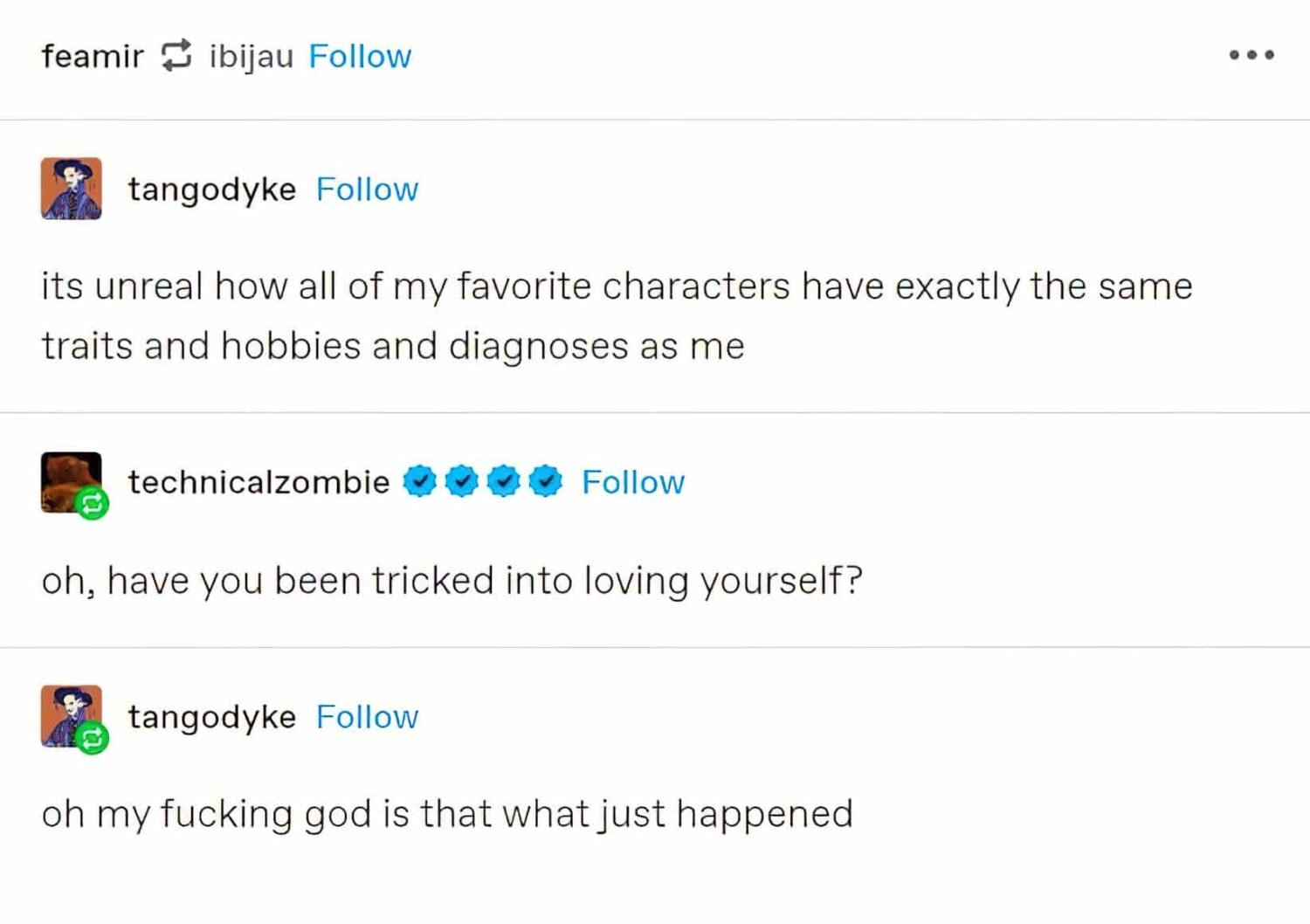
If you’ve ever had an imaginary friend as a child, rehearsed conversations before they happened, or had a crush on someone you never spoke to, you’ve engaged in behaviours associated with parasocial relationships. To the extent we can never know 100% everything about another person, every single person we encounter in life is parasocial to a lesser or greater extent. A relationship at the far end of the ‘social’ end of the social-parasocial continuum doesn’t exist.
Parasocial relationships with media personalities we’ve never interacted with are just at the extreme other end of that same continuum.
These relationships are universal, observed across cultures. Humans haven’t evolved to the point where our brains make a distinction between ‘real world’ relationships and ‘mediated’ relationships.
Fictional relationships correlate with extroversion. They generally should be considered an extension of social life rather than a problematic competitor.
49% of Americans say they have no parasocial relationship, but parasocial relationships can be a difficult thing to admit to due to stereotypes around loneliness, age, gender and fandom.
The first time I noticed that quite a lot of people on the Internet seemed to be begging celebrities to kill them was a couple of years ago. “Can lana del rey step on my throat already,” one person tweeted. “Snap my neck and hide my body,” another announced, when Lady Gaga posted a new profile photo. […] One takeaway from all this is that young people really love celebrities. Another is that we’re craving unmediated connection so desperately that we would accept it in the form of murder.
Love, Death and Begging for Celebrities to Kill You, an article archived from The New Yorker
THE BEGINNING OF A RELATIONSHIP IS SOMEWHAT PARASOCIAL
How well do you really know someone before you fall in love with them, for instance? If we take examples from literature, the cultural expectation is that, sometimes, at least, it doesn’t take long at all.
In Pride and Prejudice, Lizzie only falls in love with Darcy when he is not there. Between her rejection of his proposal when apparently he was the ‘last’ man she would marry and then his reappearance at her house having solved the problem, Greenfield has worked out that Lizzie has seen him for perhaps three hours total. Yet she has fallen in love with him. She builds her epistemology upon how things appear, and it’s only when there’s no appearance there that she learns what Darcy is really like.
Darcy, on the other hand, falls in love with Elizabeth when he sees her in her natural state, after tramping across a muddy field. Likewise, when Elizabeth sees Darcy again after reassessing his character he is walking across a field (unlike in the BBC adaptation in which case we have Colin Firth in a wet shirt — note that this scene isn’t in the book — Darcy simply walks across the field towards them).

Similarly with Bella Swan in Twilight, it’s when she’s being tracked by a group of guys intent on raping her and is saved by Edward (who takes her to a coffee shop) that Bella is separated from her ditzy friends (who are off shopping) and falls in love. Bella and Edward are now alone, and later they’re alone again, among the flowers in the woods. In both stories, the natural environment is important and symbolic: Get rid of artificiality then let nature take its course.
A storyline of Love at First Sight is too corny for most modern novelists, so the modern romantic storyline is likely to start with some sort of misunderstanding.
Lizzie Bennett needs only three hours to fall in love with Darcy. Edward needs only to ask Bella to sit with him in the canteen and wow, they’re in love.
HOW IS A PARASOCIAL RELATIONSHIP DIFFERENT FROM BEING A FAN?
The level of perceived intimacy is key. The fan begins to feel they know the celebrity like a friend, probably because the celebrity tells their audience things friends normally tell each other. There will also be repeated exposure to the celebrity, e.g. via regular social media updates, regular shows on YouTube and so on.
The person who experiences this one-sided friendship feels the friendship is very real. To lose access to the celebrity would feel similar to the loss of a friend.
Note that fandom is not necessarily about a specific personality. A fandom can be about a show, not a person or a character on that show. Fandom is when love for something becomes an integral part of someone’s identity.
Some researchers draw a distinction between parasocial relationships.
- Some fans see their celebrity as a peer or super-peer, but nonetheless, as a down-to-earth person.
- Other fans put their celebrities on a pedestal, admiring and worshipping them.
THE AUDIENCE INVOLVEMENT CONTINUUM
Audience involvement refers to the various ways we are able to connect to characters and personalities:
- Watching them on a screen (TV, movie, YouTube, TikTok)
- Playing their character in a game
IDENTIFICATION
When talking about parasocial relationships, ‘identification’ refers to when you feel like you’re merging with the other person.
If you’re watching a movie, something bad happens to a character and you also feel sad, then you are identifying with that character. This is exactly what storytellers aim for, and can be very beneficial to the audience. If we can identify with people who are from different cultures, with different identities from ourselves, stories offer opportunity to develop our skills of empathy, which has real-world impacts when dealing with people in day-to-day life.
Researchers call this parasocial contact: Learning about another group via mediation e.g. from a film or book.
Identification is a continuum, and some members of the audience may identify much harder with a particular character or media personality for a variety of complex reasons.
Identification happens when you feel like the character is you. At the extreme end, clinicians encounter people who can slip into a character so much they will say they are the character they are seeing.
In contrast, a parasocial relationship happens when you maintain a distance between yourself and the other person. Audiences move through these different connections seamlessly. While watching the one film, someone in the audience might think any or all of the following from one moment to the next:
- I really feel for this character in this situation.
- I really like this actor.
- Oh, I have a crush on this actor.
PARASOCIAL RELATIONSHIPS AND LONELINESS
The stereotype of someone with a strong parasocial relationship? She is young and lonely.
Shira Gabriel has written about a concept she calls ‘collective effervescence‘. When we go to a café, for example, others are around us. The effervescence refers to the sociality of a situation. Similarly, if turn on a TV show, we’re immersed in a similar sort of sociality.
This is a low-demand way to hang out around other people and experience sociality, if not close friendship.
It is not true that people with parasocial relationships have no friends. As we have already seen, all social relationships exist on that social-parasocial continuum. Research has not found an association between the intensity of the parasocial relationship and their level of loneliness.
See also: Loneliness in Art and Literature
Research in this area was for a long time driven by so-called Substitution Hypothesis, or Compensation Hypothesis: Lonely people seek out media friends because they don’t have real friends. With this hypothesis, we’d expect people with social deficits, social anxieties and insecure attachment styles to seek out parasocial relationships.
There is no consistent evidence of this.
What the literature does say: Parasocial relationships are just an extension of our social ties. People who are more prone to forming friendships in real life are also prone to forming parasocial relationships. The same interests and relationship styles cross over. Those who are anxious and clingy tend to wish to cling to characters as well.
It may indeed be the case that lonely people seek out more parasocial relationships, but this in turn makes them less lonely. So the literature may not tend to count them as lonely.
During covid lockdown we found out that people who were more socially isolated, or belong to marginalised or stigmatised groups (e.g. LGBTQ youth), turned more to parasocial relationships. We seek out our people by whatever means we can.
- Black Panther (2018) has been really important for Black young people.
- Girls who see woman scientists on screen are more likely to go into science themselves.
PARASOCIAL RELATIONSHIPS AND AGE
Another stereotype: Teenagers (especially girls) have intense parasocial relationships, especially with celebrities.
The same stories keep coming up: Friends, Buffy the Vampire Slayer and of course in YA book world, Harry Potter and Twilight. These are stories in which a certain segment of fans are at the extreme end of involved — they may write fanfiction or talk about the characters on fan boards across the Internet, or with their real-life friends, reading the books or watching the shows over and over again.
Is this youth bias backed up by research?
It is probably true that the most potent crushes happen to teenagers in general, whether more social or more parasocial. All romantic relationships around this age are very important.
Until quite recently research dismissed the romantic relationships of teenagers, focusing on marriage. Now we know that relationships at this age are very formative.
Parasocial relationships can also be very important later in life. They tend to become important at any transitional stage of our life. Adolescence is one big transitional stage, but we also go through transitions when we come out of a long term relationship as an adult, or suffer another kind of loss. Not all transitional periods are about loss — another example is becoming a mother.
Not all parasocial relationships are romantic. Parasocial friendships are very important in childhood (imaginary friends, enthusiasm for Bluey, Peppa Pig etc.) These relationships can develop as young as two years of age. Imaginary friends are developmentally very good for children. They advance learning. Parents and caregivers can utilise positive characters e.g. Sesame Street characters to promote fantasy play and prosocial skills.
ARE PARASOCIAL RELATIONSHIPS GENDERED?
For women, being in a secure relationship makes her more likely to become interested in fictional relationships, whereas for men the state of being anxious about one’s real world relationships makes him more likely to seek out fictional ones.
TOXIC PARASOCIAL RELATIONSHIPS
When parasocial relationships go bad, this can at times lead to stalking and other obsessive behaviours.
But this is not the norm. Stalkers tend to fit into various categories, but none of those categories equals “has parasocial relationships”. For more on categories of stalkers, see my notes on Shirley Jackson’s short story “Paranoia”.
CAN ALEXA BE YOUR FRIEND?
Humans like to impute consciousness onto inanimate objects, especially if they resemble humans e.g. robots. This is easy to do when a voice is speaking to you in your language.
The movie Her (2013) explores the increasing prevalence of machine companions. A Black Mirror episode explores the idea that grief can be lessened if the body and voice of a loved one is recreated in the form of a life-size doll. (“Be Right Back”, 2013.)
AI is not separate from humanity because it takes humans to program the AI, which in turn is based on massive amounts of human production. AI has its ups and downsides, which is beyond the scope of this article.
Other people make use of life-like dolls to fill a parasocial need. Lars and the Real Girl (2007) is based around that.
HOW HAS SOCIAL MEDIA CHANGED THE NATURE OF PARASOCIAL RELATIONSHIPS?
Social media allows access to celebrities in ways never imagined before the era of the Internet. Fans now expect their celebrities to be available, and to share at least a curated version of their life with fans.
The entertainment industry now expects personalities to create brands and to facilitate parasocial relationships. That’s part of a celebrity’s job now.
Even before social media though, this was happening for several generations already, ever since the Golden Era of Hollywood.
Originally, marketing of movies did not depend at all on the actors. Oftentimes actors were unnamed. Acting was not always a glamorous profession, and some actors were embarrassed to put their real name to a film.
But audiences would fall for the actors, and put pressure on Hollywood to release the names of their crushes. Audiences created a shift in how movies became marketed.
HOW LONG HAVE HUMANS BEEN HAVING PARASOCIAL RELATIONSHIPS?
We might argue that a relationship with a God or god is a type of parasocial relationship. We know that women had crushes on rhetoricians and theatre actors in Ancient Rome.
PARASOCIAL RELATIONSHIPS AND STORYTELLING
Some types of story, especially the Romance genre, relies on a sort of parasocial relationship between reader and characters. Even in other types of story, characters can be written as the designated identifiable ones. A good example would be Jim and Pam from The Office. These are the only sensible characters, surrounded by comedic archetypes. (As the seasons progress, even Jim and Pam become less identifiable, and The Office becomes less enjoyable as a result.)
Researchers are looking into audience reactions to fictional romances, and how audience members feel about the conflict between character relationships and the real-life relationships of the actors, e.g. Jim and Pam are a fictional couple, but the actor who plays Jim is married to Emily Blunt. How do audiences feel about that?
PARASOCIAL RELATIONSHIPS AND FANDOM
Now that we’ve established the difference between identification and parasocial relationships, and noted that these states of mind are not mutually exclusive, but ever-shifting, let’s talk about fan fiction.
Fan fiction is a way of the culture repairing the damage done in a system where contemporary myths are owned by corporations instead of by the folk.
Henry Jenkins, Director of Media Studies, MIT
TWILIGHT FANDOM
The Readers of Vampire Fiction, in particular Twilight, led to a critical revolution:
Over 100 million copies of Twilight have been sold. People never thought Harry Potter would be knocked off the top of the best sellers list. [I’m pretty sure the publishers never expected that either — otherwise the first book in the Twilight series might have been more thoughtfully copy-edited at a line level.]
Myer didn’t set out to write such a popular series [and says the idea for the story came to her as a sort of divine inspiration], but the response online from fans has been huge.
The mechanism behind this massive fandom was the fan site. Anyone can register. Users of the fan site were now able to blog, share and ask questions and write their own fan fiction. Fans are creating their own parts of the story, then posting them online for other fans to read.
Much of the fanfic includes the raunchy sex scenes Myer left out. [This indirectly led to Fifty Shades Of Grey, another phenomenon.] Stephanie Myer is apparently happy to embrace and actively support some of the actual fan sites.
Users tend to use pseudonyms. We don’t know people’s gender, age or any other identifiers. Anonymity is empowering.
There are also many negative responses to literature on other fan sites. For instance, My Twilight Purgatory is an anti-fan site on Tumblr.
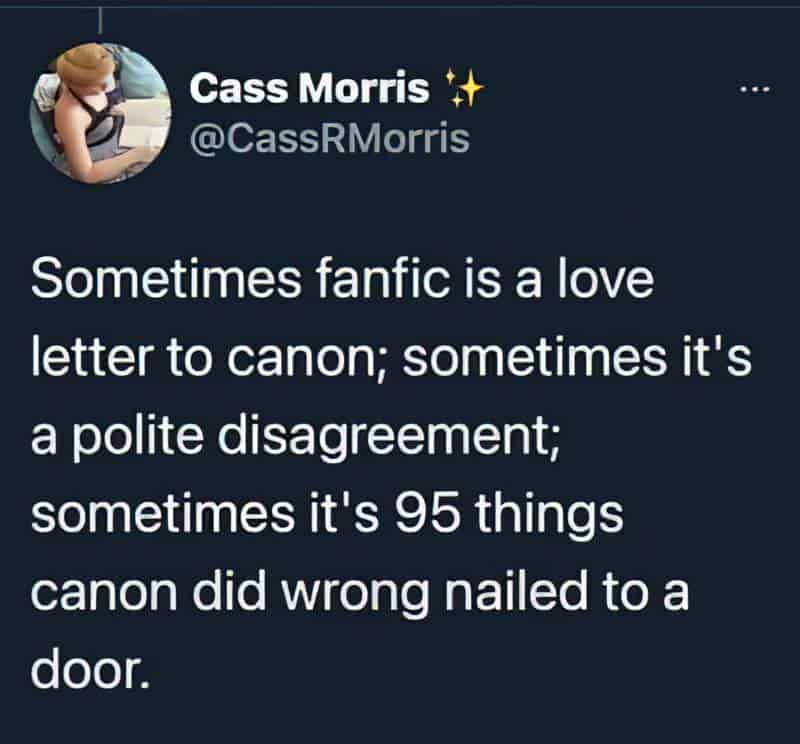

PROSUMERS

According to the Pew Internet and American Life Project, 80% of adolescents use online social network sites, 38% share original creative work online, and 21% remix their own transformative works, inspired by others’ words and images (Lenhart, Ling, Campbell, & Purcell, 2010; Lenhart, Madden, Smith, Purcell, Zickuhr, & Rainie, 2011).
Reading Today Online
In the past five years, this sort of fan activity has lead to a critical revolution leading to a new question: What is a reader and what is an author? The line has completely blurred. These fans are ‘prosumers’ – consumers who produce. The reader and the author are starting to blend and are now the same thing.
Myer’s own website lists (at the time of the lecture) 488 different fansites all about Twilight. They’re even arranged by different languages. There are at least 30 different languages. (There are plenty more unrecognised fansites.)

PEER REVIEWED, SCHMEER REVIEWED
Most of it is ‘gush and squeal’ about Edward or Jacob, and how these characters are so hot. But there is also a lot of serious commentary and worth reading. Why do we at universities make such a fuss of peer reviewed, serious academic literature when the blogs on the fansites are talking about the same things? This is causing a huge change in the nature of literary commentary.
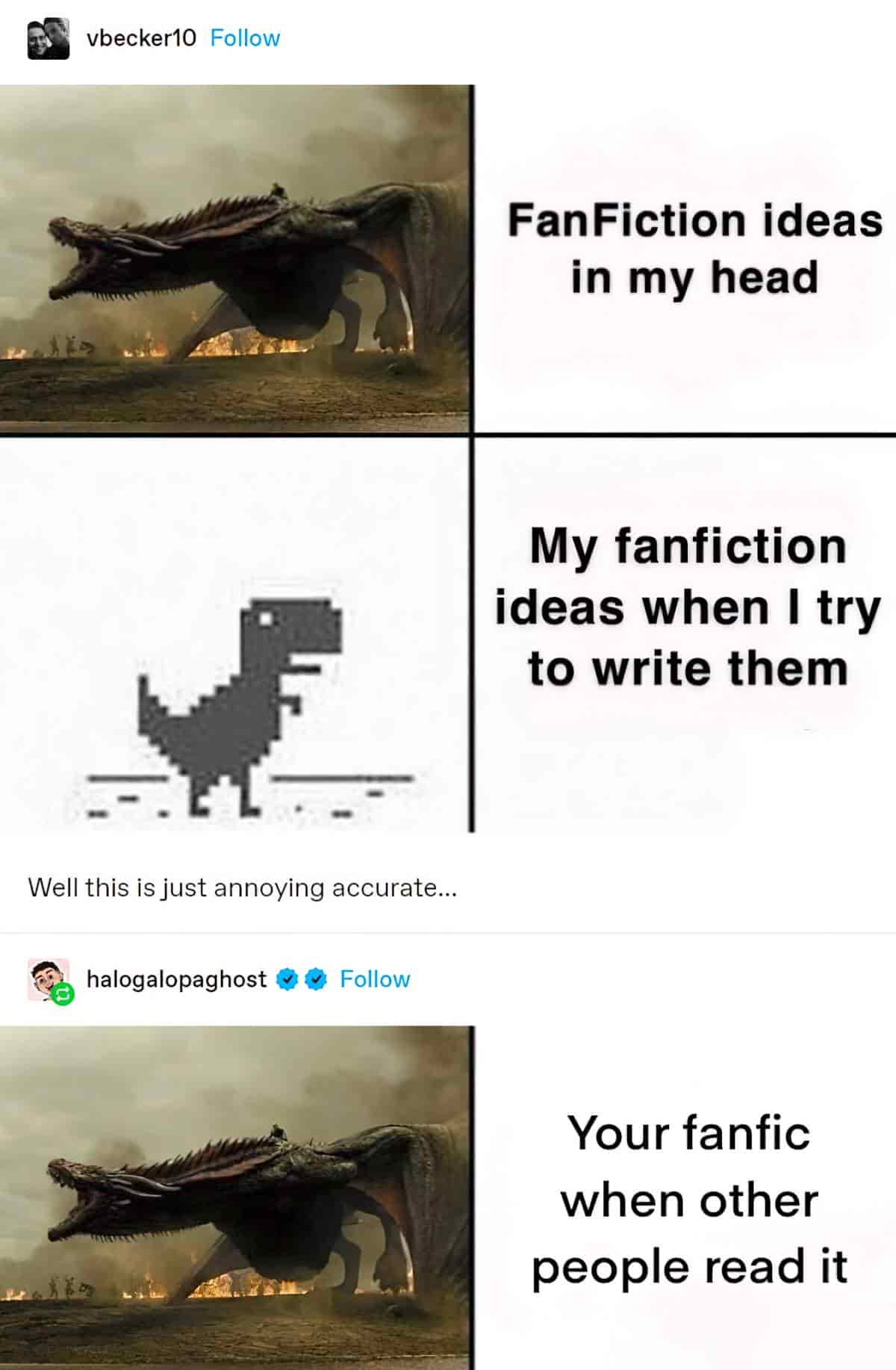
REFERENCES
What do we get from celebrity crushes? With Rebecca Tukachinsky Forster, PhD, and Karen Dill-Shackleford, PhD, Speaking of Psychology Podcast, American Psychological Association
The Oxford Handbook of Parasocial Experiences
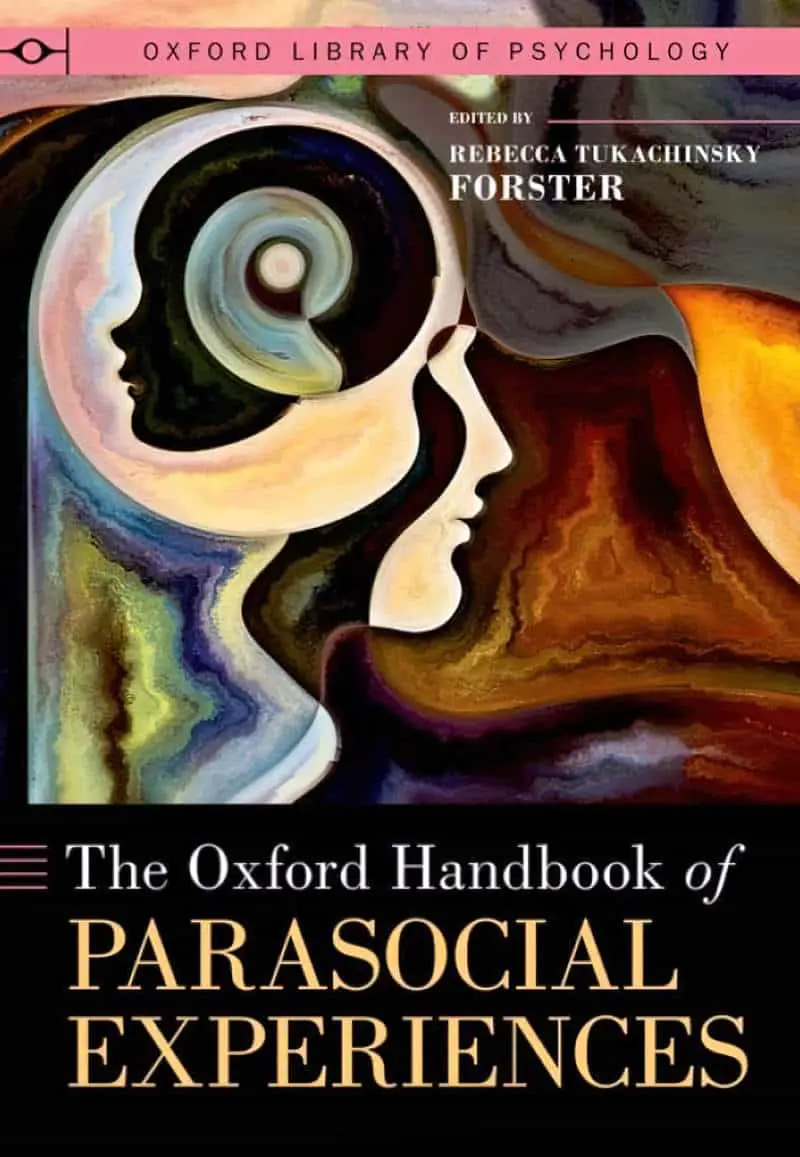
The Oxford Handbook of Parasocial Experiences examines how audiences psychologically relate to people they see in the media. Specifically, the term Parasocial Experiences (PSEs) is used to refer to parasocial relationships (PSRs) and parasocial interactions (PSIs).
The book is organized in sections:
- theoretical, conceptual, and operational definitions of PSEs;
- theoretical models and state-of-the-art review of research on PSEs across the lifespan;
- the effects of PSEs on media users’ self and their social life;
- the effects of PSEs in various contexts such as health, politics, and marketing; and
- identifying understudied areas of research that call for further investigation such as comparative cross-cultural research.
Parasocial Romantic Relationships: Falling in Love with Media Figures
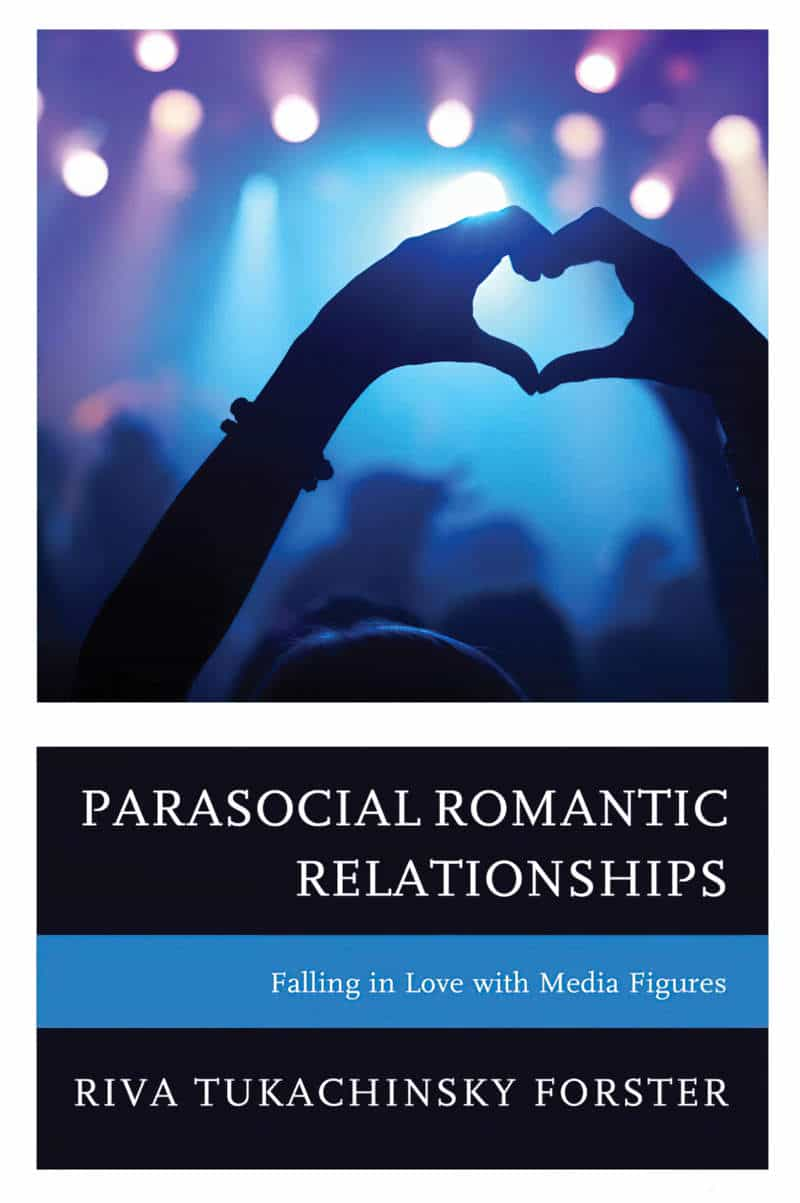
Parasocial Romantic Relationships: Falling in Love with Media Figures explores how, why, and to what effect individuals develop romantic feelings toward people they “know” from the media.
These imaginary, one-sided relationships, dubbed parasocial romantic relationships, are both profound and pervasive, Riva Tukachinsky Forster argues. These relationships can take many forms, including adolescents who develop celebrity crushes on popular music artist, anime enthusiasts who “marry” their favorite characters, and fanfiction authors who insert themselves into narratives as romantic interests of the protagonist.
Through analysis of surveys, in-depth interviews, and historical examples, this book advances our understanding of parasocial romantic relationships on both a sociocultural and a psychological level.
The data and theories analyzed offer insights into how individuals can become romantically engaged with people they do not actually know, some of whom may not even exist in reality. Ultimately, Tukachinsky Forster argues that although these relationships exist only in the mind of consumers, they serve important psychological functions across different stages of life and can lead to significant consequences for individuals’ nonmediated relationships.
Parasocial Relationships: That Podcaster is Your Friend! from Stuff You Should Know podcast
Greenfield’s Absent Minded Heroine: Or, Elizabeth Bennett Has A Thought, an analysis which looks very much at the idea of absence: how to fall in love when the person isn’t actually there. It looks at the idealisation of another person, love at first sight, and at the unreliability of appearance.
Fictional Attraction from Stuff Mom Never Told You covers some of the research that has been carried out regarding parasocial relationships.
The documentary Mechanophiles (My Car Is My Lover, 2008). Disturbing at times, these (mostly) men show that humans have a huge capacity for love, and also for imagination, specifically for imagining people (and in this case objects) can love us in return.
FANDOM, THE NEXT GENERATION
In Fandom, the Next Generation (University of Iowa Press, 2022), Bridget Kies and Megan Connor have edited the first collection to offer a close study of fan generations, which are defined not only by fans’ ages, but by their entry point into a canon or via their personal politics. Divided into three parts–Reboots, Revivals, and Nostalgia; Generations of Enduring Fandoms; and Generation Tensions–contributors further the conversation about how generational fandom is influenced by and, in turn, influences technologies, industry practices, and social and political changes. As reboot culture continues, as franchises continue expanding over time, and as new technologies enable easier access to older media, Fandom, the Next Generation offers a necessary investigation into transgenerational fandoms and intergenerational fan relationships.
interview at New Books Network
